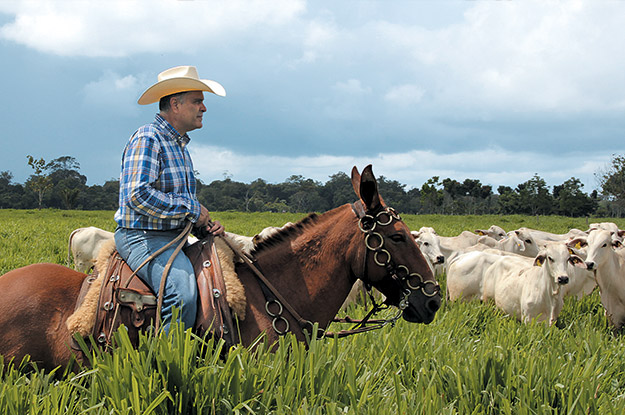In 2007, the Brazilian government named the municipality of Paragominas, in Pará state, one of the biggest culprits for deforestation of the Amazon. Ranchers there were responsible for the loss of 156 square miles of forest per year. But just a few years later, Paragominas was being hailed as a model for sustainable development in the Amazon. One of the men responsible for the drastic change was Mauro Lúcio Costa. But he’s no environmental campaigner. He’s just trying to run a business.
Costa, seldom seen without his trademark cowboy hat, knows a thing or two about ranching. It’s in his blood. His grandparents were pecuaristas, or cattle farmers. So were his parents, and Costa grew up in Minas Gerais taking care of cattle from a young age. So when he moved to Pará to take care of his family’s land, he expected it to thrive.
The reality wasn’t so simple. “We were dealing with a completely different region,” he explains. The grass used for grazing in the southeast didn’t adapt well to the new environment. The soil in the Amazon is drenched by rains that wash the nutrients away. Costa looked around at the abundance reaped by neighboring farmers and knew that it wasn’t sustainable, the product of burned forests and continual destruction of the rainforest, what he calls “ash fertility.”
“It was like a dog chasing its own tail. You never get out of the same place. You cut down, burn the area, raise cattle for 10 years, and then you need to do it all over again,” Costa told AQ. “I asked myself: What am I going to leave to my children? Something that’s worth nothing after 10 years?”
Costa tested fertilizers, rotational ranching and technology to increase productivity. The result was six to seven times more beef than farms that relied on slash-and-burn methods, and profits eight to 10 times higher. He encouraged other ranchers in the area to follow his lead, arguing not only that his sustainable approach to ranching was better for the environment, but that it was better for business. Still, not everyone was receptive.
But then the Brazilian government set Paragominas in its sights as part of an expansive effort to curtail deforestation during the 2000s. The town was “blacklisted” by the environmental ministry for being home to some of the country’s worst deforestation offenders, cutting its ranchers off from credit and investment.
It wasn’t enough that Costa had worked to sustainably care for his land. His neighbors had to do so as well. So Costa sought the leadership of Paragominas Agricultural Producers Union (SPRP). He had long worked to help his fellow ranchers develop sustainable alternatives to slash-and-burn ranching. Now, they had further incentive to follow his lead.
“It was like landing with a parachute in the middle of a war,” he says about his first year as president of the union. “The pressure was there and they (farmers) were cornered. The only way was (to listen to SPRP about) our work.”
Before long, Paragominas was off the blacklist. Even then, more and more ranchers came around to Costa’s line of thinking. Today, nearly 15 farms are working in the Pecuária Verde project, an initiative led by SPRP in partnership with the Nature Conservancy, Imazon and public universities. Costa trains more producers and cattle ranching consultants, “so they can spread their change of heart” around the region.
But Costa believes there is more work to be done. “For the big guys, government must crack the whip” by enforcing and creating new legislation, he says. “But small producers live in great poverty… . The farmers’ children are starving inside the forest.” He says they need income alternatives and incentives to leave the forest standing.
Until that happens, he fears his message to the most hard-pressed cattle producers is likely to fall on deaf ears. “I cannot say the trees are this great thing, while another person comes and offers them 500 reais to cut the trees to make coal,” he says. “He will believe the other man because that becomes food on his table overnight.”
—
Luisa Leme is a digital media journalist and filmmaker at AS/COA.




